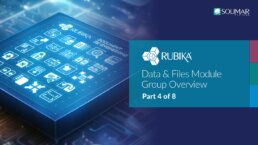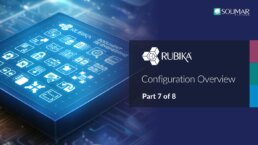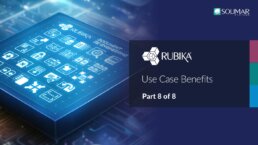Rubika Module and Configuration Overview Series
This eight part series provides a high-level overview of Rubika and where it fits into Solimar’s overall Chemistry workflow platform, along with the capabilities of its various modules and the benefits they provide to production print environments. The first generation of Rubika was introduced over 20 years ago, making it a very mature solution with lots of functionality that has reliably served our customers, ranging from small in-plants to some of the largest print centers in the world. Its capabilities have enabled cost savings along with the wide variety of improved production capabilities, and has won industry awards such as Xplor Application of the Year award with the Mayo Clinic and Partner of the Year Awards from our reseller partners.
Rubika is our versatile document enhancement and re-engineering solution designed to optimize and enrich PDF files for production, printing, and archiving workflows. It provides a user-friendly platform that allows you to modify output files directly, bypassing the need to make changes at the original composition or host systems. Rubika has 29 modules that perform various tasks to optimize your output and gain efficiencies, such as imposition, adding or updating barcodes and sequence numbers, exporting data indexed from input files, splitting or combining files, adding digital underlay and overlays, enabling postal savings, and much more.
Rubika Basic Module Group Overview: Part 2 of 8
This session provides an overview of Rubika's basic module group and the benefits they provide for production print environments. We'll go over the seven modules that are part of the basic module group. A few of the modules in the basic category are quite popular and commonly used in most Rubika workflows.
Rubika Combine & Separate Module Group: Part 3 of 8
This session provides an overview of Rubika's modules that are related to combining and separating files, and the benefits they provide for production print environments. We'll go over the seven modules related to combining and separating records and files for various input and output requirements. The combining and separating of files introduces several workflow opportunities related to job batching and postal savings concepts.
Rubika Data & Files Module Group Overview: Part 4 of 8
This session provides an overview of Rubika's data and files module group and the benefits they provide for production print environments. We'll go over the four modules that are part of the data and files group. This set of modules are related to extracting and importing information to support integration with external processes such as archive systems, data analytics, and postal software.
Rubika Imposition & N-Up Group Overview: Part 5 of 8
This session provides an overview of Rubika's imposition and N-Up module group and the benefits they provide for production environments. We'll go over the five modules that are part of the imposition and N-Up module group. This set of modules are related to rearranging the logical pages on the physical sheet size of the output for a variety of situations.
Rubika Utility Module Group Overview: Part 6 of 8
This session provides an overview of Rubika's utility module group and the benefits they provide for production print environments. We'll go over the seven modules that are part of the utility module group. These modules are grouped as utility modules, as they perform more one-off types of functionality outside of the other categories.
Rubika Configuration Overview: Part 7 of 8
This session will go over how Rubika is configured to accomplish a variety of document re-engineering objectives. Since Rubika has so many capabilities, it may seem a bit overwhelming, but it's actually not too complicated to configure once you have an understanding of some of the basics.
Rubika Use Case Benefits: Part 8 of 8
This session provides an overview of various use cases and strategies to provide examples of how Rubika benefits production print environments. This session covers a few examples about how the modules can be combined to address a wide variety of production print requirements to gain efficiencies, cost savings, and make applications compatible with your workflow.








